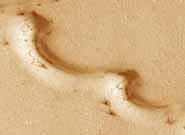| . |  |
. |
 Ithaca - February 23, 1999 - After analyzing hundreds of high-resolution pictures of the Martian surface taken by the orbiting Mars Surveyor spacecraft, a team of researchers finds that weathering and winds on the planet create landforms, especially sand dunes, remarkably similar to those in some deserts on Earth.
Ithaca - February 23, 1999 - After analyzing hundreds of high-resolution pictures of the Martian surface taken by the orbiting Mars Surveyor spacecraft, a team of researchers finds that weathering and winds on the planet create landforms, especially sand dunes, remarkably similar to those in some deserts on Earth.Newly identified smaller, bright sand dunes, the researchers speculate, are formed of sulphates, possibly gypsum. These dune fields, which are a few miles across, appear bright in photographs because of the way in which the sand particles reflect light. The much larger dark dune fields, up to tens of miles across, are most likely made of grains eroded from lava flows. At certain times of the Martian year the winds are strong enough to move these sand particles to many areas of the now-dry planet. "We can see from the high resolution that the winds are sorting these different particles out and they haven't been homogenized with the rest of the planetary dust. In one picture we can actually see the bright stuff blowing off the dunes," says Peter C. Thomas, a senior researcher at Cornell University's Center for Radiophysics and Space Research. Thomas and his colleagues, including Joseph Veverka, Cornell professor of astronomy, present their findings on the shifting dunes of Mars in this week's issue (published Feb. 17) of the journal Nature. Thomas speculates that an observer standing amid the sand dunes would be "sand blasted" at particular seasons of the year as the winds moving through the thin Martian atmosphere whip the particles along at tremendous velocity. But at other seasons of the Martian year, he says, "there would be nothing blowing at all." The researchers studied high-resolution pictures taken by the Mars Orbiter Camera (MOC) on board the Mars Global Surveyor spacecraft which took images periodically while shrinking its orbit toward the final mapping orbit reached this month. The spacecraft entered Mars orbit in September 1997. Surveyor now takes 118 minutes to circle the planet. The MOC takes images of the surface with a resolution as much as 50 times greater than the previously available pictures taken by the Viking spacecraft more than two decades ago. In many of the hundreds of pictures studied, says Thomas, the dark sand dunes, which were also visible in the Viking pictures, are sharply etched. But on eight of the images, much brighter dunes, only hinted at in one or two blurry Viking images, also are clearly visible. "We don't really know the composition of the bright dunes but we are inferring sulphates because Viking and other data showed a lot of sulphates in the Martian soil. Gypsum would be bright and soft enough to erode quickly downwind as the images indicate," says Thomas. However, he adds, the bright dunes could be formed of particles cemented by sulphates, or other minerals. The winds on Mars appear strong enough to transport sand only at certain times of the year. A major reason is the planet's eccentric orbit, which produces strong winds primarily when Mars is closest to the sun. Strong winds also are due to the fact that a third of the atmosphere falls out of the carbon dioxide polar caps, and the motion of the gas creates very strong, highly seasonal and one-directional winds at high latitudes. Until now, says Thomas, the model of the Mars atmosphere "was one of winds moving sand not very often and then pretty much in one direction at a particular spot -- and that's exactly what we are seeing. " On a broad level, he says, modelers of the Martian atmosphere have the picture right. As on Earth, the winds are selective in the particles they transport, by mass and composition. Much of the red planet is blanketed in a ubiquitous layer of dust, probably composed of rusty mixtures of clays and iron oxides. In certain areas, though, says Thomas, the wind is "cleaning off this dust" and replacing it with other particles to create the bright dunes. The sulphates, he speculates could orignally have come from weathering in ancient dry river and lake beds, from groundwater or from hot springs.
Surveyor Reports At SpaceDaily Mars 98 Reports From Spacer.Com Mission Links
Mars Coverage at Spacer.Com
Future Missions
Areography
Pathfinder
|
| |||||||||
| The content herein, unless otherwise known to be public domain, are Copyright 1995-2016 - Space Media Network. All websites are published in Australia and are solely subject to Australian law and governed by Fair Use principals for news reporting and research purposes. AFP, UPI and IANS news wire stories are copyright Agence France-Presse, United Press International and Indo-Asia News Service. ESA news reports are copyright European Space Agency. All NASA sourced material is public domain. Additional copyrights may apply in whole or part to other bona fide parties. Advertising does not imply endorsement, agreement or approval of any opinions, statements or information provided by Space Media Network on any Web page published or hosted by Space Media Network. Privacy Statement All images and articles appearing on Space Media Network have been edited or digitally altered in some way. Any requests to remove copyright material will be acted upon in a timely and appropriate manner. Any attempt to extort money from Space Media Network will be ignored and reported to Australian Law Enforcement Agencies as a potential case of financial fraud involving the use of a telephonic carriage device or postal service. |